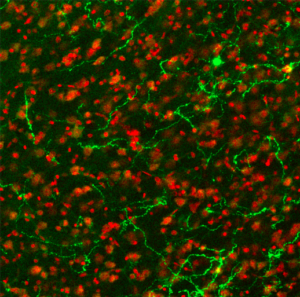Our Research
We use advanced electrophysiological and neurochemical techniques to examine the activity patterns of individual neurons as well as neuronal populations and how these are regulated via neurotransmitters (dopamine in particular). We implemented the use of a carbon fiber-based sensor that allows for the simultaneous measurement of neuronal firing and neurotransmitter release. We complement this approach with modern neuroscience techniques such as opto and chemogenetics as well as calcium imaging in freely moving animals using mini-endoscope technology and fiber photometry. These techniques are particularly useful for elucidating specific temporal relationships between behavior and brain activity.
Techniques
- Optogenetics
- Chemogenetics
- Iontophoresis
- Intra-cranial self-stimulation
- Drug self-administration
- Genetically encoded calcium indicators
- Calcium imaging neuron microscopy
- Fast-scan cyclic voltammetry (FSCV)
- Ensemble (multiple single-unit) recordings
- Fiber Photometry
- Combined FSCV and single-unit electrophysiology
Projects

Assessing the therapeutic effects of endocannabinoid degradation inhibitors and zinc finger protein therapy on the neurobiology of prodromal psychiatric symptoms in Huntington’s disease.

Endocannabinoid modulation of goal-directed behavior.

Endocannabinoid modulation of negative reinforcement.

The effects of prenatal exposure to the primary psychoactive component of marijuana (in collaboration with Miriam Melis and Istvan Katona).

Serotonin/dopamine interactions (in collaboration with Marisela Morales).

The role of subsecond dopamine release in observational learning (in collaboration with Matt Roesch).






